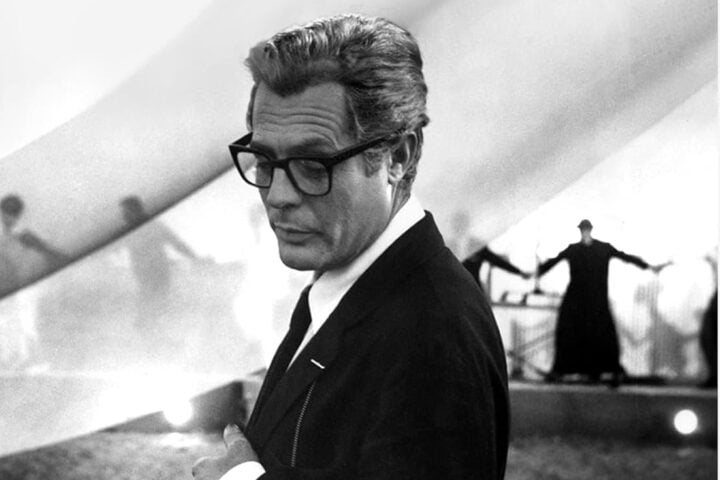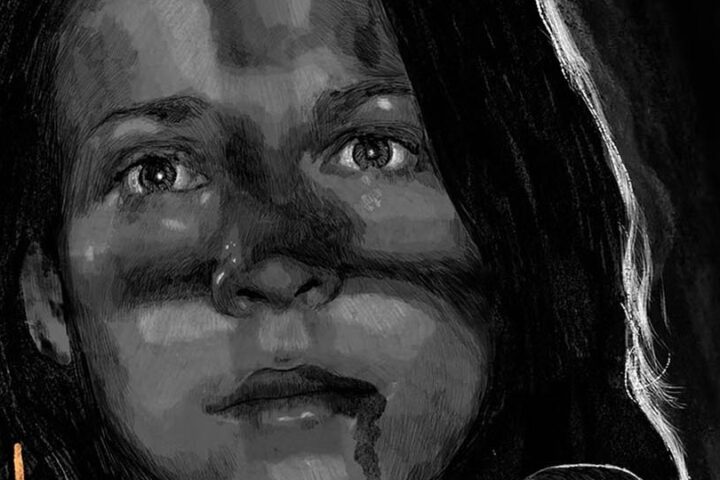The four films collected in Severin’s new set Hard Wood chronicle a seismic shift in cult filmmaker Ed Wood’s oeuvre. They see him moving from utterly idiosyncratic mashups of sci-fi and horror like Bride of the Monster and the immortal Plan 9 from Outer Space (not to mention the mockumentary delirium of Glen or Glenda?) to other perhaps less reputable pastures in the land of exploitation filmmaking. Starting with The Sinister Urge in 1960, except for one reasonably charming excursion into cornpone comedy, Wood largely confined himself to working within the increasingly explicit realm of sexploitation films.
Wood co-wrote but did not direct 1963’s Shotgun Wedding, a prime example of the hicksploitation craze that swept the nation in the early ’60s after the runaway success of the TV show The Beverley Hillbillies, which, in the world of exploitation filmmaking, bore fruit like Herschell Gordon Lewis’s gore-laden Brigadoon riff Two Thousand Maniacs! Though Wood’s storyline is brimming with simmering blood feuds, scheming double crosses, and flagrant religious hypocrisy, Shotgun Wedding is by far the kinder, gentler of the two films.
Not surprisingly, the Anchors bunch bear more than a family resemblance to the TV show’s Clampett clan, with Buford (J. Pat O’Malley) the far less amiable patriarch, Chub (Peter Colt) the lunkheaded Jethro Bodine stand-in, and Lucianne (Nan Peterson) the pigtailed Ellie Mae analogue. The film’s funniest moment occurs when hostile paterfamilias Silas (Jack Searle) calls on the duplicitous preacher (William Schallert) to bless his “Christian masacree” of the Anchors. Shambolic and amiably low-stakes, Shotgun Wedding is the outlier of this set, especially given its categorical lack of flesh on display, even including a teasingly blocked shower scene.
The films that Wood wrote and directed in this time attest to the fact that he deserves to be considered a true auteur, given his distinctive obsessions. For one, in the first few minutes of the horror-tinged Necromania: A Tale of Weird Love, from 1971, sham married couple Danny (Rick Lutze) and Shirley Carpenter (Rene Bond) name-drop Wood’s idol and frequent collaborator Bela Lugosi as they enter the allegedly spooky abode of Madame Heles, whose name is pronounced “heals,” since she reputedly heals folks of their sexual hang-ups.
There’s little effort expended on giving Madame Heles’s establishment any sort of atmosphere, aside from some cheapjack set decoration: several plastic skulls, some flimsy weaponry on the walls, and a mangy looking stuffed wolf that inexplicably manages to put the frighteners on a character. The Red Room where the sex rituals take place is dominated by one of the Amazing Criswell’s coffins, akin to the one that appeared in the Wood-scripted Orgy of the Dead. Necromania’s scant budget, supposedly a measly $2,700, clearly allowed for no fog machines, or shadowy chiaroscuro, only hideous ’70s furnishings and glaringly flat lighting schemes.
Danny and Shirley make for one of Wood’s trademark bickering couples, though it’s never made clear why they’re pretending to be married, or what difference this fact makes once it’s discovered by Heles’s acolyte, Tanya (Marie Arnold). What is clear is the basis of the duo’s discontent. Danny can’t fully get it up, and Shirley never lets him forget it. This sends them off on divergent sexual paths: Danny to make an attempt at completion with Tanya, and Shirley to an exhaustingly protracted session with Heles “inmate” Barb.
Another of Wood’s trademarks is his eminently quotable dialogue. This extends from little touches such as Tanya’s risible mangling of words like “necromancer” and “insatiable,” to howlers like, to pick but one, Shirley’s response on running into that wolf effigy: “You nearly made me wet my nightgown, old boy! It’s new too.” As evidence that he was down with the counterculture, Wood evens throws in the Laugh-In catchphrase “You bet your sweet bippy!”
Though depicted as something of a ballbuster, Shirley is the one who has by Necromania’s end “learned her sex well,” thereby graduating to a life dedicated only to sex, which seems to be Wood’s acerbic assessment of the sexual revolution unfolding around him. Danny, for his part, requires the full Heles treatment, which happens to take place in her closed coffin, thereby explicitly linking sex and death. Shirley’s path to fulfilment encompasses homosexual gratification, while Danny’s avowedly hetero route remains fraught with symbolic peril. (These notions will be replayed, with significant variation, in The Young Marrieds.)
Also from 1971, The Only House in Town is a horse of a different color. This is a ramshackle and possibly unfinished affair. The plot is negligible to the point of nonexistence. Dialogue, when it’s discernible at all, is strictly limited and decidedly not of the quotable variety. That’s not to mention the voice from off screen that occasionally pipes up to direct the action.
The film was reportedly made inside the historic Hale House in L.A., a Victorian mansion built in 1887 that boasts some distinctive stained-glass windows. This is worth mentioning because they figure prominently in at least half the camera setups and, on several occasions, Wood zooms the camera in on the colored glass and holds the shot for what feels like forever.
The film opens in the midst of a gang of vaguely hippie types, one of them menacingly wielding a switchblade, chasing a young woman (Lynn Harris) around the premises for about five full minutes. Once they catch her, though, the scene quickly switches gears to a group sex scene. Over its lengthy run time, the camera languidly moves around to linger on other decorative motifs: first a poster of the Shroud of Turin, then a Renaissance-style oil painting that apparently depicts a meeting between Marc Antony and Cleopatra. Symbolically freighted as these images may be, just what they represent in this context remains frustratingly opaque.
The scene ends as abruptly as it began with another girl standing up and confessing that she was the one who ratted the group out to the cops. After a hard cut to Russ Meyer mainstay Uschi Digard addressing the camera a la Criswell in Plan 9, we’re presented with a sort of omnibus narrative, replete with flashbacks that illustrate (more or less) what Digard’s character has been telling us about. The most Woodian touch here is the scene between Digard and a bearded fellow identified in the narration as “Louie the Louse” that captures a mood of sexual dissatisfaction and overall bitchery that matches that found in most of the other films in the set.
The Young Marrieds, from 1972, has a somewhat “bigger” feel than its companion piece, Necromania, with a larger cast and more elaborate sets. In a refreshing touch of cinema verité, Wood even manages some outdoor scenes and location shooting around downtown L.A. The storyline focuses on another discontented couple, Ben (Dick Burns) and Ginny Garrett (Alice Friedland), who seek out questionable methods (in this case wife swapping) to achieve sexual gratification. As in Necromania, this doesn’t exactly work out as planned.
The Garretts’ situation is opposite to that of the Carpenters’ in Necromania. Ben is oversexed, spending his evenings at a strip joint fantasizing about the dancers, and even picking up a hitchhiker (Cynthia Walker) in his dune buggy for some sex al fresco. Ginny is frigid—or, at least, that’s what Ben keeps telling her. She seems amenable enough to sex, and readily agrees to pose for naughty pictures. But Ben still insists she’s the problem—that is, when he isn’t spouting off about homos and queers. In other words, Ben is an unregenerate asshole, even though the film’s portentous voiceover narration keeps positioning him as the hero. Perhaps it’s meant to be ironic, because the narrative’s sting in the tail certainly suggests so.
The worst that can be said about Ginny is that she exhibits some peculiar sexual peccadilloes. At one point, after demanding to take over the roleplaying from shutterbug Ben, she demands that he whip her with his belt, indicating that she might have internalized some of Ben’s endless abuse. And then there’s the most audacious and jaw-droppingly absurdist sequence in The Young Marrieds, where Ginny pleasures herself with a lime green vibrator while watching a soap opera called The Brink of Passion, whose insipid dialogue plays over Ginny’s act of onanism, before things get really weird and the dialogue shifts to a scene involving “the genius twins” that consists entirely of children crying and asking for their grandmother.
These choices make it very difficult to think that Wood cared a fig for the erotic payload of such a scene. That’s also evident in the way he delivers the truly unexpected and quite astonishing payoff to the film’s theoretically climactic orgy. Ben’s host (Greg Black) informs him that, since Ginny participated in a lesbian tryst, Ben now must go quid pro quo with one of the men. Ben’s “comeuppance” is depicted via a montage of gay porn photographs. One wonders how this narrative curveball was received by your typical raincoat brigade audience member. Wood seems to be actively thwarting their jouissance, so to speak. Or just maybe he’s working to deconstruct the hardcore porn experience. Somebody get Žižek on the line!
Wood’s style has always been more of an anti-style, compounded by constraints of time and money as well as sheer ineptitude. Certainly Wood’s sex scenes (especially the hardcore bits inserted into Necromania and The Young Marrieds) are shot with precious little zest, let alone something like attention to effective camerawork, making them a far cry from the more sophisticated works of erotic auteurs like Joe Sarno or Radley Metzger. What they do, though, possess in spades (particularly the two films aforementioned) is that ineffable psychotronic quality, the sheer WTF factor, that renders Wood’s films unmistakably his.
Hard Wood: The Adult Features of Ed Wood is now available on Blu-ray.
Since 2001, we've brought you uncompromising, candid takes on the world of film, music, television, video games, theater, and more. Independently owned and operated publications like Slant have been hit hard in recent years, but we’re committed to keeping our content free and accessible—meaning no paywalls or fees.
If you like what we do, please consider subscribing to our Patreon or making a donation.



